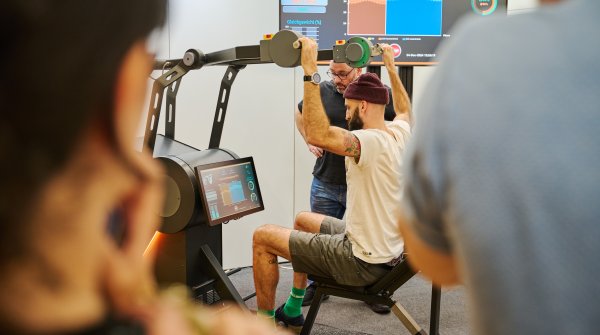
Basically, Zumba is healthy. However, in a gym in South Korea, it made 112 course participants sick: According to research of Dankook University Hospital in Cheonan infected with SARS-CoV-2 while dancing. The scientists who published the work suspect that the confined space in which the courses took place contributed to the infection - but also the intensive sporting activity.
But what are the greatest risks of infection in gyms and how can they be minimized? These are the questions Prof. Dr. Henning Wackerhage from the Faculty of Sports and Health Sciences of the Technical University (TU) Munich. The sports biologist was part of a multidisciplinary team of scientists commissioned by the German Industrial Association for Fitness and Health to prepare an expert opinion for the reopening after the lockdown. In some federal states, gyms were allowed to reopen in May, in others at the beginning of June - and now have to comply with strict hygiene regulations.
"Covid-19 is known to have three pathways of infection," explains Wackerhage: "Droplet infection through coughing or sneezing, infection via surfaces and infection via aerosols," which are air clouds containing infectious particles. In fitness studios, surfaces are a particular danger, according to the sports scientist at the ISPO Re.Start Days. Infected persons touch door handles, dumbbells or handles of sports equipment, for example, without having washed their hands beforehand. If a healthy person touches the same surface and rubs his eyes afterwards, he will become infected. Studies have shown that SARS-CoV-2 adheres to some surfaces for more than 24 hours if not disinfected.

The risk of infection via aerosols is also high during sports. They occur when infected people talk or shout, and remain in the air much longer indoors than outdoors, where wind spreads the particles quickly. "Aerosols certainly contributed to the infection at the Zumba courses in South Korea, where the trainers loudly cheered the participants on," Wackerhage suspects. The rather poor ventilation in the rooms of gyms further increases the risk of infection.
What many people underestimate is the danger that comes from the sport itself: due to the high intensity of stress during training. The respiratory minute volume, i.e. the amount of air that a person lets flow through their lungs per minute, increases sharply under athletic stress, explains Wackerhage: "From 5 to 10 liters at rest to more than 100 liters per minute under maximum load. This means that infected people exhale more of the virus during training and healthy people inhale more under stress". In gyms where many people work out together in a relatively small space, the risk of infection would be many times higher.

Sports biologist Wackerhage was part of the six-member team of scientists who were to develop a concept for reopening the gyms after the lockdown. Under the motto "Health needs fitness" the experts have prepared an expert report with a five-point plan to help the gyms restart. At the ISPO Re.Start Days, Wackerhage summarized the following tips for operators and members to keep the risk of infection in fitness gyms as low as possible:
- Trainer should use microphones when conducting a course - then they don't have to shout so loud and produce less infectious aerosol clouds if they are carrying the virus. Overall, instructors should keep the cheering within limits and keep a low profile.
- Athletes should refrain from intensive exertion in order not to push their respiratory minute volume too high. Distance to other athletes and trainers is mandatory.
- If possible, after each course the open the window and take a 15 minute break for ventilation.
- Air conditioning are safer if they do not let the air circulate, but add fresh air to the room.
- Gym operators should keep abreast of corona outbreaks in their county and inform their staff and members if the infection rates in the area begin to rise.
- Additional barriers like plexiglass panes at reception protect staff and customers.
- Before and after the gym visit, all those present should wash your hands and disinfect if possible. It is important not to touch your face, because viruses can then get onto mucous membranes and penetrate the body.
A Study from Oslo comes to a reassuring conclusion and confirms Wackerhage's concept: If everyone in the gym adheres strictly to hygiene regulations and keeps their distance from each other, the risk of infection is no greater there than elsewhere.
- Awards
- Mountain sports
- Bike
- Fitness
- Health
- ISPO Munich
- Running
- Brands
- Sustainability
- Olympia
- OutDoor
- Promotion
- Sports Business
- Textrends
- Triathlon
- Water sports
- Winter sports
- eSports
- SportsTech
- OutDoor by ISPO
- Heroes
- Transformation
- Sport Fashion
- Urban Culture
- Challenges of a CEO
- Trade fairs
- Sports
- Find the Balance
- Product reviews
- Newsletter Exclusive Area
- Magazine






